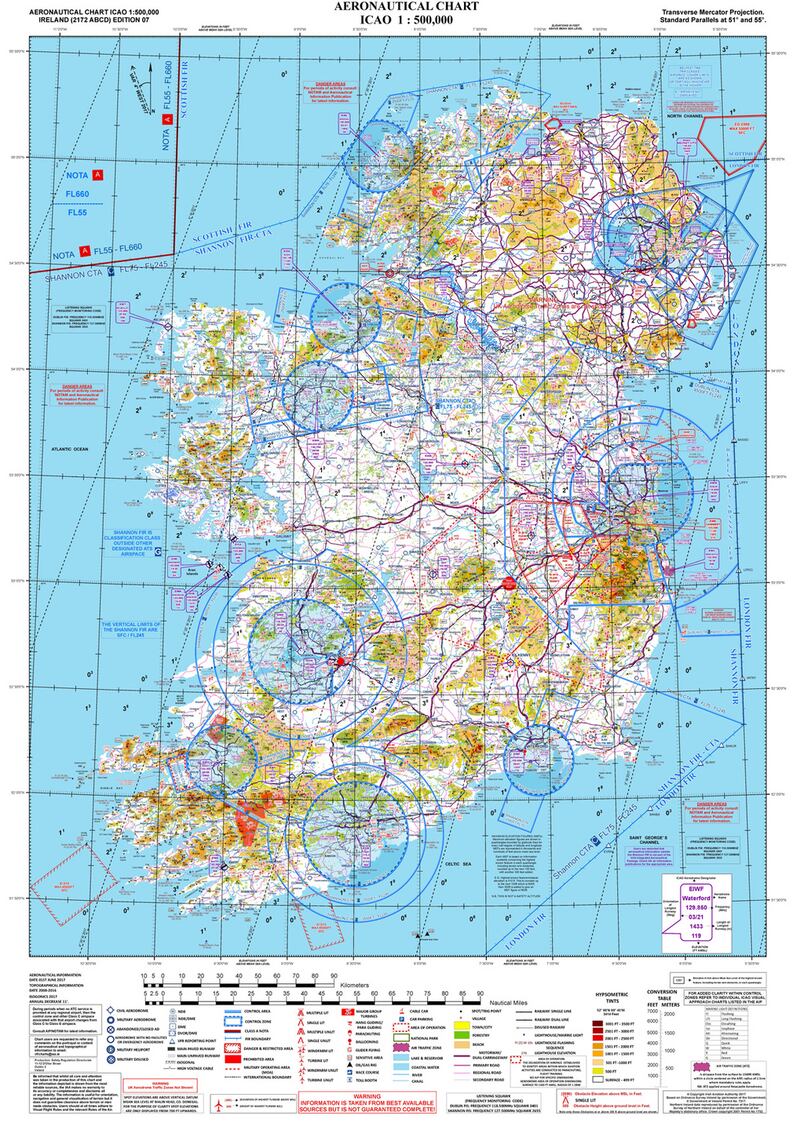The Irish Aviation Authority has asked search-and-rescue and other pilots to help correct the aeronautical charts they use. Lighthouses in the wrong locations, missing spot heights and obscured symbols are among the errors in the authority's latest visual-flight-rules 1:500,000 chart, published last June, it has conceded.
The Air Accident Investigation Unit highlighted errors and anomalies in navigational information and systems in a preliminary report on the loss of all four crew when the Irish Coast Guard's Rescue 116 helicopter crashed into Blackrock Island, off north Co Mayo, on March 14th.
The aviation authority invited pilots earlier this month to report any errors or make suggestions for future editions of visual-flight-rules charts, which are used most frequently by search-and-rescue, helicopter-transport and recreational pilots. It says it plans to hold a "charting workshop" in January to review submissions and correct errors before the next chart is published, in April.
The Irish Air Line Pilots' Association has welcomed the move but expressed frustration at the authority's failure to fully consult it on maps and charts and on other safety-related issues. The association's president, Capt Evan Cullen, said that even though it is listed as a stakeholder on the IAA website "we have never been invited to a workshop on maps and charts, and other complaints we raised have not been addressed by the IAA." Pilots would participate in any effort to improve accuracy and safety, he added.
Two of the four Rescue 116 crew, Capt Dara Fitzpatrick and Capt Mark Duffy, were members of the union. The bodies of their winch team, Paul Ormsby and Ciarán Smith, have still not been found.
The IAA told The Irish Times that charting workshops were "held on a regular basis", as "charting is, and will remain, a continual process and priority" for it, and the January workshop will involve a "wide range of stakeholders". Asked what procedure was used to ensure accuracy, the IAA said that all maps and charts were produced "in accordance with International Civil Aviation Organisation standards and recommended practices.

Map errors
Further errors in maps still in use after the crash, such as anomalies for the mountainous terrain on Achill island, in Co Mayo, and inaccurate depictions of Skellig Michael, off Co Kerry, and Fastnet Rock, off Co Cork, were recently identified by RTÉ's Prime Time. It also reported that search-and-rescue crews had been complaining about poor maps and navigation equipment for months before the crash.
Although the IAA is responsible for the accuracy of aeronautical charts, it says it does not guarantee their accuracy or completeness and disclaims all liability.
The Dublin-based Rescue 116 helicopter had been asked to provide top cover – or relay communications back to base – for a medical evacuation off the west coast at night, and was relying on instruments rather than visual-flight-rules charts.
The Air Accident Investigation Unit’s preliminary report noted that Blackrock Island was listed as a waypoint on the route selected for refuelling at Blacksod, nine nautical miles, or 16.5km, to the east, in Co Mayo. Although the route guide identified a lighthouse on the rock with an associated height of 310ft, or 94.5m, electronic maps aboard the helicopter gave “varied to no” information on it. Blackrock rises 282ft, or 86m, above sea level at its highest point.
Prime Time also reported last October that the pilots were testing a new electronic mapping system that showed Blackrock Island as 46ft, or 14m.
A separate ground-proximity warning system did not have the island in its database. The IAA says it has no role in data provided in such systems, which are “a matter of contract between the aircraft operator and the system provider”.
The preliminary crash report recommended that CHC Ireland, which provides the helicopter service for the Irish Coast Guard, re-evaluate all route guides used by search-and-rescue helicopters . It also identified a flaw in the installation of locator beacons on crew life jackets.
CHC Ireland has said it has "established, documented and implemented an integrated safety system" and continues to collaborate with regulators and others to improve safety. It says its focus remains on "supporting the families and friends of all those affected" by the crash.













